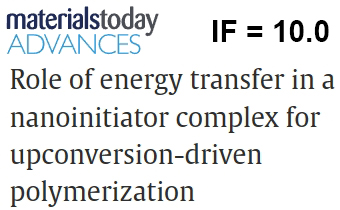Press-room / news / Science news /
Role of energy transfer in a nanoinitiator complex for upconversion-driven polymerization
The researchers from the Laboratory of Polymers for Biology, Institute of Bioorganic Chemistry RAS, together with colleagues from the Federal Scientific Research Center «Crystallography and Photonics» RAS and other institutes, have demonstrated an effective strategy for the polymerization of photocurable compositions (PCC) using a nanoinitiator based on upconversion nanoparticles (UCNPs), activated by near infrared (NIR) light.
NaYF4:Yb3+, Tm3+/NaYF4 UCNP samples, capable of NIR light conversion into UV and visible light, were synthesized to study the mechanism of energy transfer in a donor-acceptor pair with commercially available photoinitiators such as LAP and Irgacure 369. The affinity of hydrophilic components to hydrophobic UCNPs was maintained with polyethylene glycol diacrylate (PEG-DA). To determine the mechanism of resonant energy transfer, the lifetime of UCNP photoluminescence in the presence of an acceptor (LAP or Irgacure 369) was studied. It has been found that in the case of PCC, containing the water-soluble LAP photoinitiator, energy transfer is carried out by a photon-mediated mechanism (LRET), and in the case of PCC with water-insoluble Irgacure 369, it is due to nonradiative resonant energy transfer (FRET). The difference in the spatial resolution between polymer structures is demonstrated according to the mechanism of energy transfer. The developed PCCs, consisting of UCNPs, photoinitiator, and PEG-DA can act as nanoinitiators for curing PCC with endogenous hydrophilic biopolymers. An example of NIR 3D printing has been demonstrated on the photopolymerization of methacrylated hyaluronic acid and gelatin. A significant advantage of the developed nanophotoinitiator system is the absence of preliminary UCNP surface modification, independence from the solubility of the photoinitiator in water, and, consequently, the expansion of the choice of biopolymers which undergo radical photocrosslinking reaction.
The work was published in Materials Today Advances.

Figure 1. Schematic illustration of energy transfer from an upconversion nanoparticle to a photoinitiator molecule by the mechanism of non-radiative resonant energy transfer (FRET) or photon-mediated energy transfer (LRET). Voxel formation in a PCC followed by polymerization in a pixel. The UCNP/LAP system implements a photon-mediated energy transfer process, which leads to an increase in the pixel size. In the case of UCNP/Irgacure 369, there is a FRET process that inhibits the propagation of photons in the PCC and results in polymerization localized within the voxel size. Image of the resulted gelatin polymer structure between microscope coverslips. Scale bar is 5 mm.
july 21, 2023


